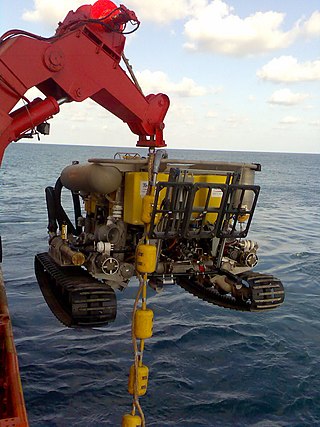Top Qs
Timeline
Chat
Perspective
Bottom crawler
Vehicle for underwater exploration and work From Wikipedia, the free encyclopedia
Remove ads
A bottom crawler is an underwater exploration, research and work vehicle.[1] It is designed to sink to the bottom of a body of water, where it uses the traction of its wheels or tracks against the bottom and can move a load.[1] It can be manned or unmanned.[1] It can tethered to a surface ship by a cable or cables providing power, control, video, and lifting capabilities, but this is not essential.

Remove ads
Applications
Such devices have been proposed for use in deep sea mining.[2]
It was considered as a platform for nuclear missiles, but was rejected because it is restricted to essentially two dimensions, unlike a ballistic missile submarine.[3]
Limitations
Its use is limited by the composition of the bottom; unless it is firm, the crawler can become immobilized by sinking into sediment.[1] Another serious problem is that the tracks or wheels can stir up the sediment, causing it to seriously degrade vision.[1]
Its power source can be internal (batteries) or external (cable), but each presents problems.[1] Batteries are heavy and have limited capacity for sizable loads, while power cables can impede mobility.[1]
Remove ads
Remote Underwater Manipulator
In 1958, Victor Anderson began constructing the 10-ton, unmanned Remote Underwater Manipulator (RUM) for the Scripps Institution of Oceanography which was based on a United States Marine Corps self-propelled rifle carrier.[4] He attached a boom and claw which enabled it to manipulate objects up to 5 metres (16 ft) away.[4] RUM was initially powered by a gasoline engine, but it was replaced by two electric motors.[4] It is paired with the Ocean Research Buoy (ORB), a barge with a center well.[4] RUM is lowered by crane, then a coaxial cable is attached for power and sensor signals.[4]
RUM has taken core samples at depths down to 1,900 metres (6,200 ft) and has recovered equipment from 1,260 metres (4,130 ft).[4]
See also
- Benthic lander, an autonomous observational platform that sits on the seabed
References
Wikiwand - on
Seamless Wikipedia browsing. On steroids.
Remove ads
